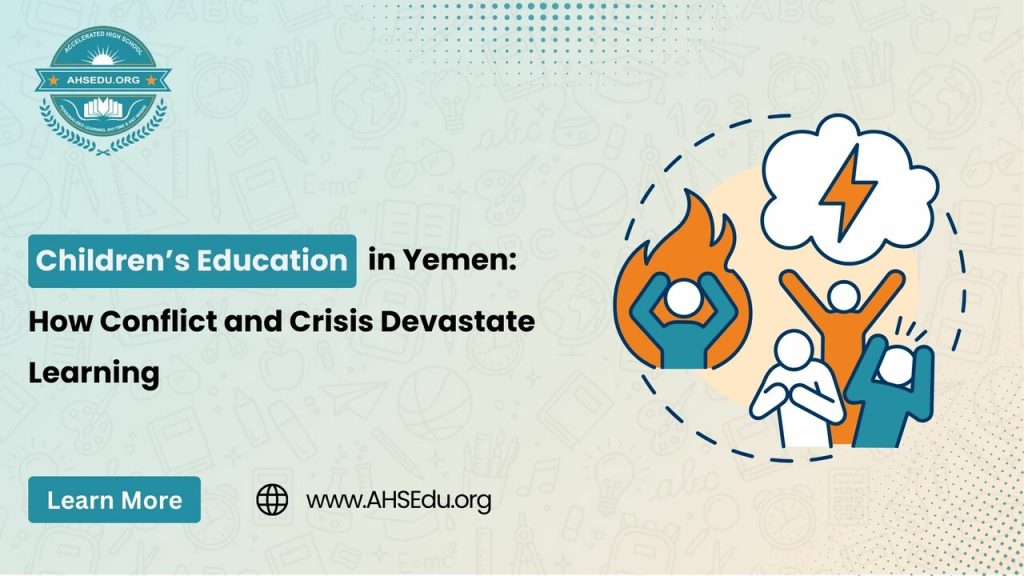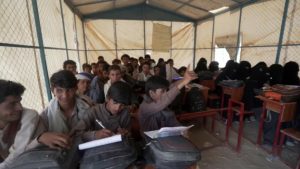
A Generation at Risk
Yemen is facing one of the world’s worst education crises amid an ongoing conflict and humanitarian disaster. After a decade of war, millions of Yemeni children are out of school. In fact, two in every five children – about 4.5 million young learners – are now out of school despite a UN-brokered truce, a number that has soared in recent years. Over 6.2 million children require educational support, and 1 in 4 children in Yemen are not attending school at all. This collapse of education is a direct consequence of the conflict and “current problems” plaguing Yemen. The nation’s civil war and humanitarian crisis have put an entire generation’s future at stake. Below, we examine what triggered this education emergency, the background of the crisis, its impact and consequences for children, and what to expect next – along with solutions that can help, such as the AHS education platform, to ensure Yemeni students continue learning.
What Triggered Yemen’s Education Crisis?
Yemen’s descent into crisis began with civil war in 2015, when conflict erupted between the government and Houthi rebels. This war quickly escalated into a regional conflict, causing widespread destruction and economic collapse. Even before the war, Yemen struggled with poverty and poor infrastructure, but the fighting made things far worse. Schools became battlegrounds – since 2015, at least 2,424 schools have been destroyed or damaged by attacks, or used as shelters and military posts. Repeated airstrikes, shelling, and violence have devastated education infrastructure.
The conflict triggered mass displacement of families, as roughly 4.5 million people have been internally displaced across Yemen. Many displaced families took shelter in camps or crowded housing where schooling is scarce. Children forced to flee their homes often cannot attend school, since there may be no functioning schools in displacement camps or they cannot afford transport. In fact, internally displaced children face huge obstacles: more than 2.5 million displaced children are out of or not attending school, and 8.6 million school-aged children in Yemen need education assistance.

Various shots of the destroyed schools in Taiz city and during the student’s classes in their temporary school-like buildings. Wagdi Almaqtari/ICRC
Another trigger of the education crisis is Yemen’s economic collapse and humanitarian emergency. A decade of war has shrunk Yemen’s economy by over 50%, with more than 80% of the population now living below the poverty line. Today, over 19 million people (more than half of Yemen’s population) need humanitarian aid, including around 10 million children. Families struggling to survive face famine, disease, and extreme poverty, making education a lower priority when food and safety are in question. The government’s budget for public services evaporated amid the war, leading to a collapse in education funding. Teachers went unpaid for years – nearly 200,000 teachers have not received regular salaries since the war divided the country’s administration. This salary crisis means teachers quit to find other work, leaving classrooms without educators.
In summary, the current problems triggering Yemen’s education crisis are rooted in the ongoing conflict and its ripple effects: violence destroying schools, mass displacement, economic meltdown, and a collapsing education system. A UNICEF representative in Yemen described education as one of the greatest casualties of the war, noting that “the conflict has a staggering impact on every aspect of children’s lives, yet access to education provides a sense of normalcy for children in even the most desperate contexts and protects them from exploitation. Keeping children in school is critical for their own future and the future of Yemen.” unicef.org
Impact on Children’s Education: By the Numbers
The impact of Yemen’s turmoil on children’s education is dire and measurable. Here are some key statistics illustrating the scope of the crisis:
These numbers underscore a bleak reality: Yemen’s conflict has created an education emergency. Classrooms have emptied out, and progress made in school enrollment over past decades has been reversed. As Save the Children’s Yemen director noted, “Nine years into this forgotten conflict, we are confronting an education emergency like never before… We must act now to protect these children and their future.” savethechildren.net The loss of learning today will have a profound effect on the country’s recovery tomorrow, as discussed next.
A Lost Generation and Long-Term Fallout
The consequences of Yemen’s education collapse are deep and long-lasting. If current trends continue, Yemen could face a “lost generation” – millions of children who miss out on schooling and whose lives are permanently altered as a result. Key repercussions include:
Students play outside during lunchtime at the Saeed Hasan Fare’a School on Monday, Nov. 11, 2024, in the Alshamayatain district, Taiz, Yemen. (Anas Hassan Ahmed Ahmed Al Haj/AP Images for GPE)
Despite these grave consequences, Yemeni children and parents continue to value education highly. Many displaced families prioritize getting their kids into any learning programs available, knowing that education is their children’s “only path to a better future.” savethechildren.net Communities have called for schools to be spared from attacks and for rebuilding of damaged schools, demonstrating hope and resilience. This resilience shows that if support is provided, Yemeni children are eager to learn – which is where global help and innovative solutions become crucial.
What’s Next: Prospects and Hope for Yemen’s Students
Going forward, the outlook for children’s education in Yemen depends on peace efforts and increased support. An UN-brokered truce in 2022 offered a glimmer of stability, but without a lasting political settlement, sporadic violence and uncertainty continue. If a durable ceasefire or peace agreement is reached, we can expect a gradual rebuilding of the education system: reconstruction of schools, return of teachers (especially if salary payments resume), and investment in catching up the lost learners. Yemen’s future recovery plans all note that education must be a priority to avoid losing another generation. Humanitarian groups are urging that schools be kept safe and open even as peace is negotiated.
However, if the conflict drags on or funding shortfalls worsen, the education situation could further deteriorate. Aid agencies warn that without more support, schools will continue to close and more children will drop out. International funding for education in Yemen has been declining in recent years due to donor fatigue and other global crises. This has already led to cutbacks in programs that kept kids in school. The expectation, if nothing changes, is that even more than 4.5 million children could be out of school in the coming years. UNICEF has warned that the number of children facing education disruption in Yemen could rise to 6 million in the near future if action isn’t taken.
On a hopeful note, Yemen’s youth remain determined. Many continue their studies in whatever form possible – community-run classes, temporary learning centers, or self-study – waiting for a chance to return to a real classroom. Humanitarian organizations, local communities, and some authorities are working together to provide alternative education where they can. For example, nearly 23,000 displaced children were supported with temporary learning spaces by UNICEF in 2023, and innovative approaches like radio education or psychosocial support in learning are being implemented. Education Cannot Wait, a global fund for education in crises, and other partners are also investing in Yemen to build resilience in the education system. These efforts give a glimpse of what is possible if more resources and stability are achieved.
In the meantime, digital learning and remote education solutions have emerged as a beacon of hope to keep children learning even when schools are inaccessible. During COVID-19 and throughout the conflict, some Yemeni students have turned to online resources and radio/TV lessons. This is where platforms like AHS come into play as an innovative solution to Yemen’s education challenges.
How AHS Can Help Yemeni Students
While waiting for peace and rebuilding, technology and online learning can bridge the gap for Yemen’s students. AHS is one example of a platform providing free and affordable online school courses to children worldwide, including those in conflict zones. AHS offers a high-quality curriculum aligned with U.S. State Standards, meaning Yemeni children can access a standardized, internationally-recognized education online. Importantly, AHS is designed with accessibility in mind – it provides offline-accessible tools for students in areas with unreliable internet. In a country like Yemen, where electricity and connectivity are often disrupted, this feature is crucial. Even in remote villages or displacement camps, students could continue learning via offline content and then sync when they have a connection.
AHS’s mission is to ensure every learner has the tools to succeed regardless of circumstances. “We envision a world where every student, regardless of their circumstances, has access to high-quality education,” the platform’s founders state, emphasizing a commitment to education without boundaries. The platform not only delivers lessons but also includes interactive exercises, videos, and personalized learning experiences that adapt to each student. For children traumatized by war or forced to study on their own, these interactive and engaging materials can make a huge difference in keeping them motivated.
Crucially, AHS is not just for individual students at home – it actively partners with schools and non-profits to support education in crisis areas. As part of its pledge, AHS aims to “provide support for schools, organizations, and non-profits to ensure quality education delivery.” This means that schools in Yemen (or working with Yemeni refugees) can collaborate with AHS to implement its curriculum for their students, and NGOs can use AHS resources in their learning programs on the ground. By leveraging such partnerships, even schools that have lost buildings or teachers could continue classes virtually or via blended learning, ensuring children’s education isn’t entirely halted by conflict.
In light of Yemen’s education emergency, we urge schools, educational institutions, and non-profit organizations working with Yemeni children to explore digital learning solutions like AHS. By doing so, they can maintain continuity of education for students despite the challenging environment. Every child has the right to learn, and even war should not strip that away. Platforms like AHS provide an immediate way to uphold that right. Schools can sign up for a free AHS demo to see how the online curriculum can integrate with their needs, and non-profits can request a demo tailored for humanitarian settings. These demos allow organizations to evaluate AHS’s tools – from offline lesson plans to interactive modules – and understand how they can be deployed in Yemen or similar contexts.
By adopting such innovative solutions, we can ensure Yemeni students keep learning today, building the skills and hope they need for tomorrow. Yemen’s children have shown incredible resilience and a desire to learn against all odds. It is the responsibility of the international community, educators, and humanitarian actors to give them the support and tools to do so. Quality education can’t wait – not even for war. As one group of Yemeni children advocates passionately demanded, they want their schools to be “spared from war and used for education alone”, knowing that education is their only path to a better future.

AHSEDU.org offers personalized learning for every student. With a curriculum standardized with USA State Standards, Free interactive videos, Fun and interactive learning content, Constructive assessments, and take-home worksheets we address the unique educational needs of each learner to ensure success.